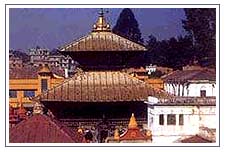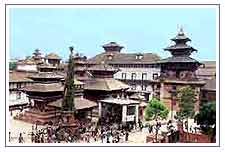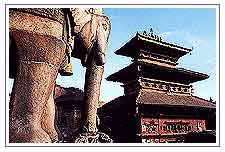
Kathmandu
- Travel to Kathmandu valley in Nepal which offers a plethora of tourist
attractions in Nepal including mountain peaks, temples, stupas and lots
of adventure activities to do there.
Duration: 06 Nights - 07 Days
Duration: 07 Nights - 08 Days
Duration: 08 Nights - 09 Days
Duration: 09 Nights - 10 Days
Duration: 11 Nights - 12 Days
Duration: 05 Nights - 06 Days
Kathmandu Valley Travel
| Importance: |
Capital of Nepal |
| Altitude: |
1,336 m |
| Best Time To Visit: |
Throughout The Year |
|
|
Kathmandu valley consists of three main cities of great historic and
cultural interest
Kathmandu,
Lalitpur
(Patan) and
Bhaktapur (Bhadgaon). Situated at an
altitude of 1,336 m, the Kathmandu valley covers an area of 218-sq-miles.
The major tourist attractions in Kathmandu
Machchhendrananth Temple:
The temple of Sweta Machchhendra Bahal between Indra Chowk and Asan. It is
a Pagoda of considerable artistic beauty is also called as "Janmadyo"
or "Machchhendra" deity.
Akash Bhairav Temple:
A three storey temple in the main market avenue, called Indra Chowk, the
image of Akash Bhairav is displayed outside for a week during Indara Jatra,
the festival of Indra - the God of Rain.
Hanumandhoka (Durbar
Square):
It is the historic seat of royalty. The Durbar Square, with its old temples
and places, epitomizes the religiuous and cultural life of the people. It is
here that kings of Nepal are crowned and their coronations solemnized.
Interesting things to see here are; Taleju Temple built by king Mahendra
malla in 1549 A.D.; Kal Bhairav, the God of Destruction, Nautalle Durbar,
Coronation Nasal Chowk, The Gaddi Baithak, the statue of King Pratap Malla,
the Big Bell, Big Drum and the Jagannath Temple.
On the right hand corner, larger wooden lattice screen hides an enormous
gilded face of Sweta Bhairav. The screen is removed only during the Indra
Jatra festival. There are also Numismatic Museum and Tribhuvan museum inside
the Hanuman Dhoka Palace building. Photography is prohibited inside the
museums. Both the museums remain closed on Tuesdays and government holidays.
Temple Of Kumari (Kumar Ghar): The temple or the residence of Living
Goddess, "Kumari", is situated in the vicinity of Hanuman Dhoka
Palace. The building has profusely carved wooden balconies and window
screens. The Kumari - the Living Goddess, acknowledges the greetings from
her balcony window. Photography is prohibited.
Kasthamandap:

Located
near the Temple of Kumari, it is said to have been built by King Laxmi
Narsingha Malla in the beginning of the 16th century. It is said to be
constructed from the wood of a single tree. The city of Kathmandu derives
its name from this temple.
Tundikhel:
A huge green field, flanks one entire side of the old city Tundikhel. Some
of the important landmarks of Kathmandu valley are located in the periphery
of this area. At the south-western end of Tundihkel is a 59.29m tower built
by prime minister Bhimsen Thapa in 1832 A.D. known as Dharahara or Bhimsen
Stambha. Sundhara - fountains with golden water spouts is situated at the
foot of this great tower also belonging to the same period.
Bhadrakali Temple:
As the eastern edge of the Tundikhel, near Shahid Gate stands the temple of
Goddess Bhadrakali. This temple is also known as Lumarhi temple and is one
of the main "Shakta" temples of Kathmandu city.
Budhanikantha:
About 8-kms north of Kathmandu, at the base of sivapuri hill is a
remarkable colossal statue of Lord Vishnu, reclining of the bed of snake.
This is one of the masterpieces of stone sculptures of Lichchhavi period.
This 5th century statue is in the middle of a small pond and seems to float
in water.
Swayambhunath:
This is one of the world's most glorious Buddhist Chaityas. It is said
to be 2,000-years-old. Painted on the four-sides of the spire bases are the
all seeing eyes of Lord Buddha. It is 3-kms west of Kathmandu City and is
situated on a hillock about 77m. Above the level of the Kathmandu valley.
National Museum:
Two and half kilometers west of Kathmandu, the National Museum has splendid
collection of weapons, artifacts from ancient, medieval and modern Nepal.
Its archaeological and historical displays are worth seeing. The museum is
open everyday except Tuesday and government holidays.
Natural History Museum:
Situated 3-kms west of Kathmandu City behind the famous Swayambhunath
hillock. This museum has a unique collection of butterflies, fish, reptiles,
birds, mammals, plants and a variety of fossils collected within the
country. Photography inside the museum is prohibited.
Pashupatinath Temple:

Situated
5-kms east of Kathmandu, the temple of Lord Shiva-Pashupatinath with two
tiered golden roof and silver doors is famous for its superb architecture.
Visitors can clearly seen the temple and the activities performed in the
temple premises from the eastern bank of the Bagmati River.
Guheswari Temple:
Near Pashupatinath is located another historic and holy temple of
Guheswari. Only Hindus are allowed to enter the temple courtyard.
Chabahil:
The lovely stupa of Chabahil is believed to have been built by Charumati,
the daughter of the Indian emperor Ashoka, in the 3rd century B.C. There are
ancient statues around the stupa.
Chandra Vinayak:
The temple of Chandra Vinayak is situated about 200 m. north of Chabahil
stupa. This double tiered brass roofed temple houses a tiny image of Lord
Ganesh, the Elephant-headed God.
Bouddhnath:
The Stupa of Bouddhnath lies 8-kms east of Kathmandu. This colossal and
ancient stupa is one of the biggest in the world.
Gokarna:
This lovely Toyal Game Sanctuary, also known as Gokarna Safari Park, lies
about 10-kms north-east of Kathmandu. Many wild animals such as Spotted Deer
can be viewed in the sanctuary from an Elephant back. On the northern side
of Gokarna, is a Pagoda of Gokarneshwor Mahadev.
Kirtipur:
It is a small town, 8-kms south-west of Kathmandu on the top of a hill.
Tribhuvan University is located at the foot of the hill. This historic town
has many things to offer like old shrines and temples, old houses, the
people typically dressed in old traditional costumes, people working on
ancient loom etc.
Chobhar:
Situated 9-kms south-west of Kathmandu, this place is famous for its gorge.
All the water of the valley drain through it. There is a small but
picturesque temple of adinath on the top of a hill. From this top one can
have a panoramic view of snow capped mountain peaks.
Shekha Narayan:
Situated between Chobhar and Dakshinkali the temple of Shekha Narayan
represents one of the four Narayans of the Kathmandu valley. The other three
Narayans are Changu Narayan of Bhaktapur, Visankhu Narayan of Patan and
Ichangu Narayan of Kathmandu.
Dakshinkali:
The temple of Dashinkali is situated about 2-kms south of Shekha Narayan.
Dakshinkali is regarded as one of most important Hindu Goddesses pilgrims
visit this temple to offer their prayer and animal sacrifices to the
Goddess. Besides, this place has been developed as a popular picnic spot.
The major tourist attractions in Lalitpur (Patan):
This ancient
city of Patan also known as Lalitpur of the city of fine arts is about 5-kms
south-east of Kathmandu. The city is full of Hindu temples and Buddhist
monuments. The major tourist attractions of Patan are
Durbar Square:

Patan
Durbar Square, situated in the heart of the city consitutes the focus of
visitor's attraction. The square is full of ancient palaces, temples
and shrines, noted for their exquisitevings. The Patan Durbar Square
consists of three main chowks or courtyards, the Central Mul Chowk, Sundari
Chowk and Keshav Narayan Chowk. The Sundari Chowk holds in its centre a
masterpiece of stone architecture, the royal bath called "Tushahity".
Krishna Mandir:
Built in the 17th century, the temple of Lord Krishna holds a commanding
position in the palace complex of Patan. It is supposed to be the first
specimen of Shikhara style architecture in Nepal. It is the only temple in
Nepal having 21 spires and is completely made of stone.
Mahaboudha:
A little further east from Patan Durbar Square lies this Buddhist temple
made of clay bricks in which thousands of images of Lord Buddha engraved.
The terra-cotta structure is one of the 14th century Nepalese architectural
masterpieces.
Hiranya Verna Mahavihar:
Located inside, kwabadehal, this three storey golden pagoda of lokshwor
(Lord Buddha) was built in the twelfth century by king bhaskar verma. Inside
the upper storey of the pagoda,a re the golden image of lord buddha and a
large prayer wheel.
Rudra Varna Mahavihar:
This unique buddhist monastery contains fine and amazing collection of
images and statues in metal, stone and wood. It is believed that the kings
in the ancient times were crowned in this monastery. Many of the treasures
offered by the devotees can be seen here even today.
The Ashokan Stupas:
There are four ancient stupas popularly believed to have been built in 250
B.C. by emperor ahoka at the four corners of patan. The four stupas are
situated in Pulchowk, lagankhel, ebahi and in teta (way to sano gaon)
respectively. These stupas give evidence to the city's ancient
religious importance.
Temple Of Machhendranath And Minnath:
The Pagoda of red Machhendranath built in 1408 A.D. is situated in Tabahal.
For six months the deity is taken to its other shrine in Bungmati. The
temple of Minnath is situated in Tangal on the way to Tabahal.
The Zoo:
Situated at Jawalakhel, the zoo has many animals, birds and reptiles in its
collections mostly representing the Himalayan fauna. There is a beautiful
pond built in 17th century A.D.
Phulchowki:
Located around 10-km south-east of Patan, this mountain, 2,758 m. High, is
a good spot for hiking. A Buddhist shrine is situated on the top of the
hill, which can be reached through a jeepable road.
The major tourist attractions in Bhaktapur (Bhadgaon):
Situated at
an altitude of 1,401m Bhaktapur covers an area of 4-sq-miles. Shaped like a
conch-shell, Bhaktapur means the city of devotees. Pottery and weaving are
its traditional industries. The city lies about 14-kms east of Kathmandu and
can be reached by public transport and by trolley buses. The major
sightseeing places in bhaktapur include:
Durbar Square:
The main square of the city contains innumerable temples and other
architectural showpieces like the lion gate, the statue of King Bhupatindra
Malla, the picture gallery, the golden gate, the palace of 55 windows, the
batsala temple and the bell of barking dogs, etc. The statue of the King
Bhupatindra Malla in the act of worship is placed on a column facing the
palace of the many statues available in Nepal this is considered to be the
most magnificent.
The National Art Gallery:
Contains ancient and medieval paintings belonging to Hindu and Buddhist
schools depicting Tantrism of various periods and descriptions.
The Golden Gate is the entrance to the main countyard of the palace of 55
windows. Built King Ranjit Malla, the gate is one of the most beautiful and
richly carved specimens of its kind in the entire world. This gate is
embellished with deities and monsters of marvellous intricacy.
The Palace of 55 Windows was built in the 17th century by King Bhupatindra
Malla. Among the brick walls with their gracious setting and sculptural
design, is a balcony of 55 windows. This balcony is a masterpiece of wood
carving.
The Stone Temple of Batsala Devi which is also located in the Durbar Square
is full of intricate carvings. This temple also sets a beautiful example of
Shikhara style of architecture in nepal. There is a bronze be on the terrace
of the temple which is also known as the "bell of barking dogs".
This colossal bell, placed in 1737 A.D. was used to sound curfew during that
time.
Nyatapola Temple:

This
five storey Pagoda was built in 1702 A.D. by King Bhupatindra Malla. It
stands in a five-terraced platform. On each of the terraces squat a pair of
figures; two famous wrestlers, two Elephants, two Lions, two Griffins and "Baghini"
and "Singhini" - the Tiger and the Lion Goddesses. This is one of
the tallest Pagodas and is famous for its massive structure and subtle
workmanship.
Bhairavnath Temple:
This temple was first built as a one storey pagoda but later chaned into a
three storey temple in 1718 A.D. by king bhupatindra malla. The temple is
noted for its artistic grandeur. It is dedicated to lord bhairav- the god of
terror.
Dattatraya Temple:
Built in 1427 A.D. this temple is said to have been built from trunk of a
single tree. Near this temple is a monastery with exquisitely carved peacock
windows
Surya Vinayak:
Situated in a beautiful surrounding of Bhadgaon, the temple of Ganesh is
placed in a sylvan setting to catch the first rays of the rising sun. It is
a good picnic spot flanked by many attractive landscapes.
Changu Narayan:
Situated at the end of a long ridge which runs well into the valley, it is
said to have been built by King Hari Dutta in 323 A.D. and said to be the
oldest temple in the valley.
Nagarkot:
Nagarkot is a popular tourist resort of Nepal. It is situated 32-kms East
of kathmandu at an altitude of 2,175 m. Above the sealevel. The panorama of
the major peaks of eastern nepal himalayas including sagarmatha (MT.
Everest) can be seen from here.
Travel Packages of Kathmandu
|
Duration
: 19 Nights - 18 Days
Places Covered :Kathmandu - Nyalama -
Saga - Prayang - Darchen - Mt. Kailash - Maansarovar Lake -
Kathmandu |
|
|
Duration
:09 Nights -10 Days
Places Covered :Delhi - Kathmandu -
Patan - Chitwan - Pokhara - Dhulikhel - Kathmandu - Delhi |
|
|
Duration
:09 Nights -10 Days
Places Covered :Delhi - Kathmandu -
Patan - Chitwan - Pokhara - Dhulikhel - Kathmandu - Delhi |
|
|


 Located
near the Temple of Kumari, it is said to have been built by King Laxmi
Narsingha Malla in the beginning of the 16th century. It is said to be
constructed from the wood of a single tree. The city of Kathmandu derives
its name from this temple.
Located
near the Temple of Kumari, it is said to have been built by King Laxmi
Narsingha Malla in the beginning of the 16th century. It is said to be
constructed from the wood of a single tree. The city of Kathmandu derives
its name from this temple. Situated
5-kms east of Kathmandu, the temple of Lord Shiva-Pashupatinath with two
tiered golden roof and silver doors is famous for its superb architecture.
Visitors can clearly seen the temple and the activities performed in the
temple premises from the eastern bank of the Bagmati River.
Situated
5-kms east of Kathmandu, the temple of Lord Shiva-Pashupatinath with two
tiered golden roof and silver doors is famous for its superb architecture.
Visitors can clearly seen the temple and the activities performed in the
temple premises from the eastern bank of the Bagmati River. Patan
Durbar Square, situated in the heart of the city consitutes the focus of
visitor's attraction. The square is full of ancient palaces, temples
and shrines, noted for their exquisitevings. The Patan Durbar Square
consists of three main chowks or courtyards, the Central Mul Chowk, Sundari
Chowk and Keshav Narayan Chowk. The Sundari Chowk holds in its centre a
masterpiece of stone architecture, the royal bath called "Tushahity".
Patan
Durbar Square, situated in the heart of the city consitutes the focus of
visitor's attraction. The square is full of ancient palaces, temples
and shrines, noted for their exquisitevings. The Patan Durbar Square
consists of three main chowks or courtyards, the Central Mul Chowk, Sundari
Chowk and Keshav Narayan Chowk. The Sundari Chowk holds in its centre a
masterpiece of stone architecture, the royal bath called "Tushahity".  This
five storey Pagoda was built in 1702 A.D. by King Bhupatindra Malla. It
stands in a five-terraced platform. On each of the terraces squat a pair of
figures; two famous wrestlers, two Elephants, two Lions, two Griffins and "Baghini"
and "Singhini" - the Tiger and the Lion Goddesses. This is one of
the tallest Pagodas and is famous for its massive structure and subtle
workmanship.
This
five storey Pagoda was built in 1702 A.D. by King Bhupatindra Malla. It
stands in a five-terraced platform. On each of the terraces squat a pair of
figures; two famous wrestlers, two Elephants, two Lions, two Griffins and "Baghini"
and "Singhini" - the Tiger and the Lion Goddesses. This is one of
the tallest Pagodas and is famous for its massive structure and subtle
workmanship.